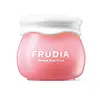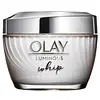What's inside
What's inside
 Key Ingredients
Key Ingredients

 Benefits
Benefits

 Concerns
Concerns

 Ingredients Side-by-side
Ingredients Side-by-side

Punica Granatum Fruit Extract 63%
AntioxidantGlycerin
HumectantButylene Glycol
HumectantCaprylic/Capric Triglyceride
MaskingCyclopentasiloxane
EmollientDiisostearyl Malate
EmollientPentaerythrityl Tetraethylhexanoate
EmollientDimethicone
EmollientCyclohexasiloxane
Emollient1,2-Hexanediol
Skin ConditioningTrehalose
HumectantGlyceryl Stearate
EmollientPEG-100 Stearate
Sorbitan Stearate
EmulsifyingWater
Skin ConditioningGlyceryl Caprylate
EmollientPEG-240/Hdi Copolymer Bis-Decyltetradeceth-20 Ether
StabilisingPolyglyceryl-3 Methylglucose Distearate
EmulsifyingHydroxyethyl Acrylate/Sodium Acryloyldimethyl Taurate Copolymer
Emulsion StabilisingChlorphenesin
AntimicrobialSodium Polyacrylate
AbsorbentDimethicone/Vinyl Dimethicone Crosspolymer
Skin ConditioningParfum
MaskingEthylhexyl Stearate
EmollientCoco-Caprylate/Caprate
EmollientSucrose Cocoate
EmulsifyingAdenosine
Skin ConditioningGlyceryl Acrylate/Acrylic Acid Copolymer
HumectantDisodium EDTA
Polysorbate 60
EmulsifyingSorbitan Isostearate
EmulsifyingPrunus Armeniaca Kernel Oil
MaskingVitis Vinifera Seed Oil
EmollientTrideceth-6
EmulsifyingCitrus Paradisi Seed Oil
PerfumingMangifera Indica Seed Oil
EmollientPunica Granatum Seed Oil
EmollientSolanum Lycopersicum Seed Oil
EmollientCI 14700
Cosmetic ColorantTocopherol
AntioxidantPunica Granatum Fruit Extract 63%, Glycerin, Butylene Glycol, Caprylic/Capric Triglyceride, Cyclopentasiloxane, Diisostearyl Malate, Pentaerythrityl Tetraethylhexanoate, Dimethicone, Cyclohexasiloxane, 1,2-Hexanediol, Trehalose, Glyceryl Stearate, PEG-100 Stearate, Sorbitan Stearate, Water, Glyceryl Caprylate, PEG-240/Hdi Copolymer Bis-Decyltetradeceth-20 Ether, Polyglyceryl-3 Methylglucose Distearate, Hydroxyethyl Acrylate/Sodium Acryloyldimethyl Taurate Copolymer, Chlorphenesin, Sodium Polyacrylate, Dimethicone/Vinyl Dimethicone Crosspolymer, Parfum, Ethylhexyl Stearate, Coco-Caprylate/Caprate, Sucrose Cocoate, Adenosine, Glyceryl Acrylate/Acrylic Acid Copolymer, Disodium EDTA, Polysorbate 60, Sorbitan Isostearate, Prunus Armeniaca Kernel Oil, Vitis Vinifera Seed Oil, Trideceth-6, Citrus Paradisi Seed Oil, Mangifera Indica Seed Oil, Punica Granatum Seed Oil, Solanum Lycopersicum Seed Oil, CI 14700, Tocopherol
Water
Skin ConditioningVinyl Dimethicone/Methicone Silsesquioxane Crosspolymer
Glycerin
HumectantNiacinamide
SmoothingIsohexadecane
EmollientIsopropyl Isostearate
EmollientPanthenol
Skin ConditioningCamellia Sinensis Leaf Extract
AntimicrobialDimethicone
EmollientStearyl Alcohol
EmollientSodium Polyacrylate Starch
AbsorbentCetyl Alcohol
EmollientCaprylyl Glycol
Emollient1,2-Hexanediol
Skin ConditioningPhenoxyethanol
PreservativeInositol
HumectantBehenyl Alcohol
EmollientDimethiconol
EmollientPEG-100 Stearate
Parfum
MaskingCetearyl Glucoside
EmulsifyingCetearyl Alcohol
EmollientStearic Acid
CleansingPalmitic Acid
EmollientBHT
AntioxidantDisodium EDTA
Zinc Gluconate
Skin ConditioningMagnesium Aspartate
Skin ConditioningCopper Gluconate
Skin ConditioningWater, Vinyl Dimethicone/Methicone Silsesquioxane Crosspolymer, Glycerin, Niacinamide, Isohexadecane, Isopropyl Isostearate, Panthenol, Camellia Sinensis Leaf Extract, Dimethicone, Stearyl Alcohol, Sodium Polyacrylate Starch, Cetyl Alcohol, Caprylyl Glycol, 1,2-Hexanediol, Phenoxyethanol, Inositol, Behenyl Alcohol, Dimethiconol, PEG-100 Stearate, Parfum, Cetearyl Glucoside, Cetearyl Alcohol, Stearic Acid, Palmitic Acid, BHT, Disodium EDTA, Zinc Gluconate, Magnesium Aspartate, Copper Gluconate
 Reviews
Reviews

Ingredients Explained
These ingredients are found in both products.
Ingredients higher up in an ingredient list are typically present in a larger amount.
1,2-Hexanediol is a synthetic liquid and another multi-functional powerhouse.
It is a:
- Humectant, drawing moisture into the skin
- Emollient, helping to soften skin
- Solvent, dispersing and stabilizing formulas
- Preservative booster, enhancing the antimicrobial activity of other preservatives
Dimethicone is a type of synthetic silicone created from natural materials such as quartz.
What it does:
Dimethicone comes in different viscosities:
Depending on the viscosity, dimethicone has different properties.
Ingredients lists don't always show which type is used, so we recommend reaching out to the brand if you have questions about the viscosity.
This ingredient is unlikely to cause irritation because it does not get absorbed into skin. However, people with silicone allergies should be careful about using this ingredient.
Note: Dimethicone may contribute to pilling. This is because it is not oil or water soluble, so pilling may occur when layered with products. When mixed with heavy oils in a formula, the outcome is also quite greasy.
Learn more about DimethiconeDisodium EDTA plays a role in making products more stable by aiding other preservatives.
It is a chelating agent, meaning it neutralizes metal ions that may be found in a product.
Disodium EDTA is a salt of edetic acid and is found to be safe in cosmetic ingredients.
Learn more about Disodium EDTAGlycerin is already naturally found in your skin. It helps moisturize and protect your skin.
A study from 2016 found glycerin to be more effective as a humectant than AHAs and hyaluronic acid.
As a humectant, it helps the skin stay hydrated by pulling moisture to your skin. The low molecular weight of glycerin allows it to pull moisture into the deeper layers of your skin.
Hydrated skin improves your skin barrier; Your skin barrier helps protect against irritants and bacteria.
Glycerin has also been found to have antimicrobial and antiviral properties. Due to these properties, glycerin is often used in wound and burn treatments.
In cosmetics, glycerin is usually derived from plants such as soybean or palm. However, it can also be sourced from animals, such as tallow or animal fat.
This ingredient is organic, colorless, odorless, and non-toxic.
Glycerin is the name for this ingredient in American English. British English uses Glycerol/Glycerine.
Learn more about GlycerinParfum is a catch-all term for an ingredient or more that is used to give a scent to products.
Also called "fragrance", this ingredient can be a blend of hundreds of chemicals or plant oils. This means every product with "fragrance" or "parfum" in the ingredients list is a different mixture.
For instance, Habanolide is a proprietary trade name for a specific aroma chemical. When used as a fragrance ingredient in cosmetics, most aroma chemicals fall under the broad labeling category of “FRAGRANCE” or “PARFUM” according to EU and US regulations.
The term 'parfum' or 'fragrance' is not regulated in many countries. In many cases, it is up to the brand to define this term.
For instance, many brands choose to label themselves as "fragrance-free" because they are not using synthetic fragrances. However, their products may still contain ingredients such as essential oils that are considered a fragrance by INCI standards.
One example is Calendula flower extract. Calendula is an essential oil that still imparts a scent or 'fragrance'.
Depending on the blend, the ingredients in the mixture can cause allergies and sensitivities on the skin. Some ingredients that are known EU allergens include linalool and citronellol.
Parfum can also be used to mask or cover an unpleasant scent.
The bottom line is: not all fragrances/parfum/ingredients are created equally. If you are worried about fragrances, we recommend taking a closer look at an ingredient. And of course, we always recommend speaking with a professional.
Learn more about ParfumPeg-100 Stearate is an emollient and emulsifier. As an emollient, it helps keep skin soft by trapping moisture in. On the other hand, emulsifiers help prevent oil and water from separating in a product.
PEGS are a hydrophilic polyether compound . There are 100 ethylene oxide monomers in Peg-100 Stearate. Peg-100 Stearate is polyethylene glycol ester of stearic acid.
Water. It's the most common cosmetic ingredient of all. You'll usually see it at the top of ingredient lists, meaning that it makes up the largest part of the product.
So why is it so popular? Water most often acts as a solvent - this means that it helps dissolve other ingredients into the formulation.
You'll also recognize water as that liquid we all need to stay alive. If you see this, drink a glass of water. Stay hydrated!
Learn more about Water